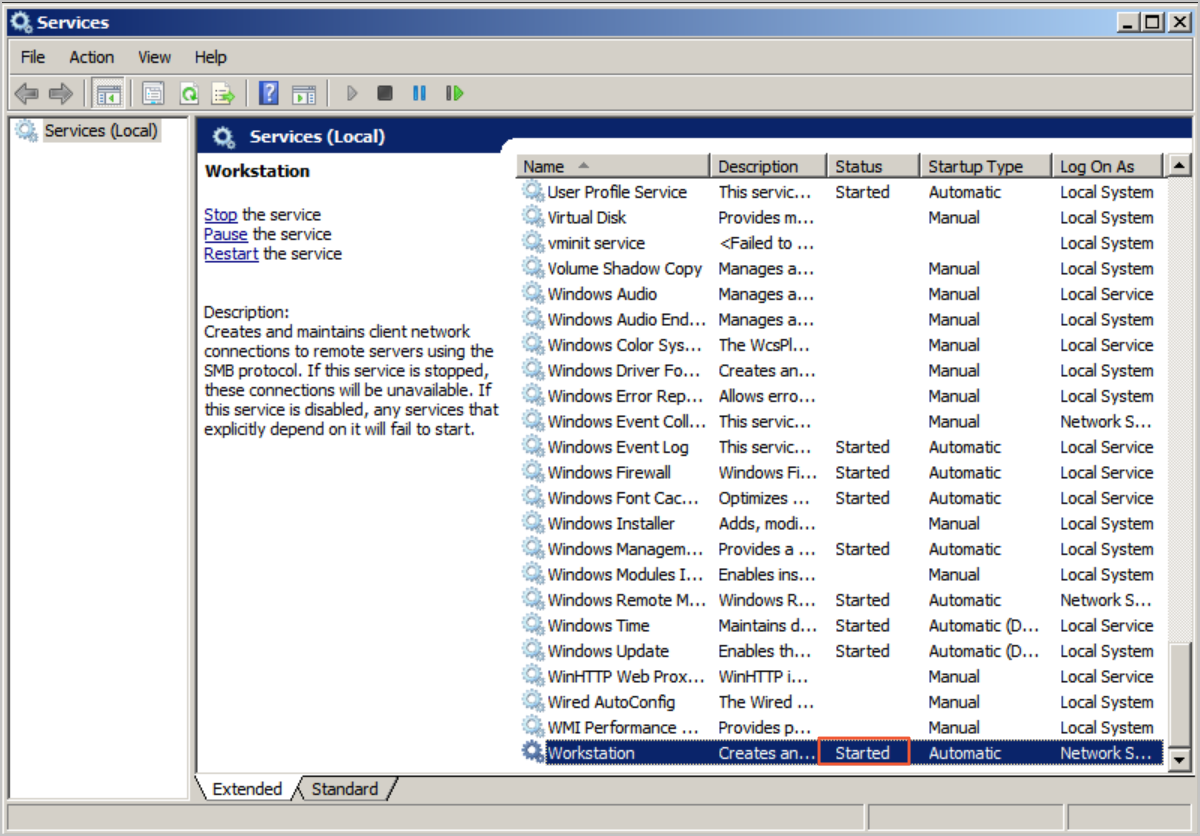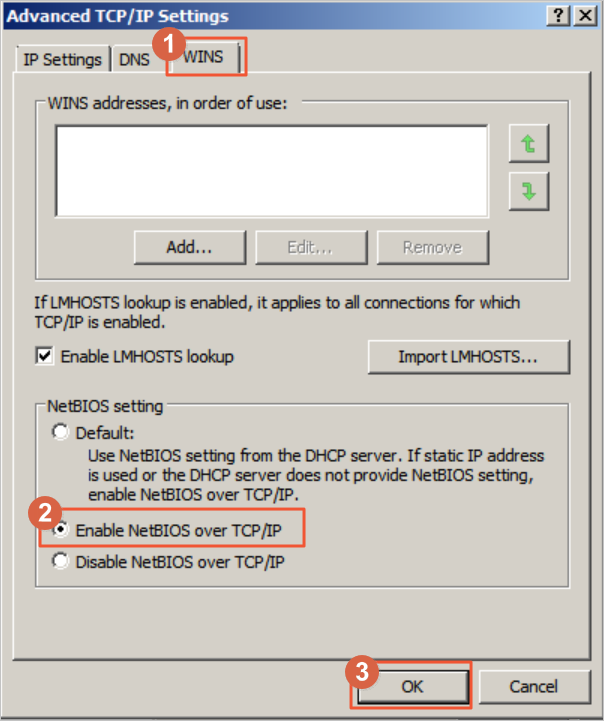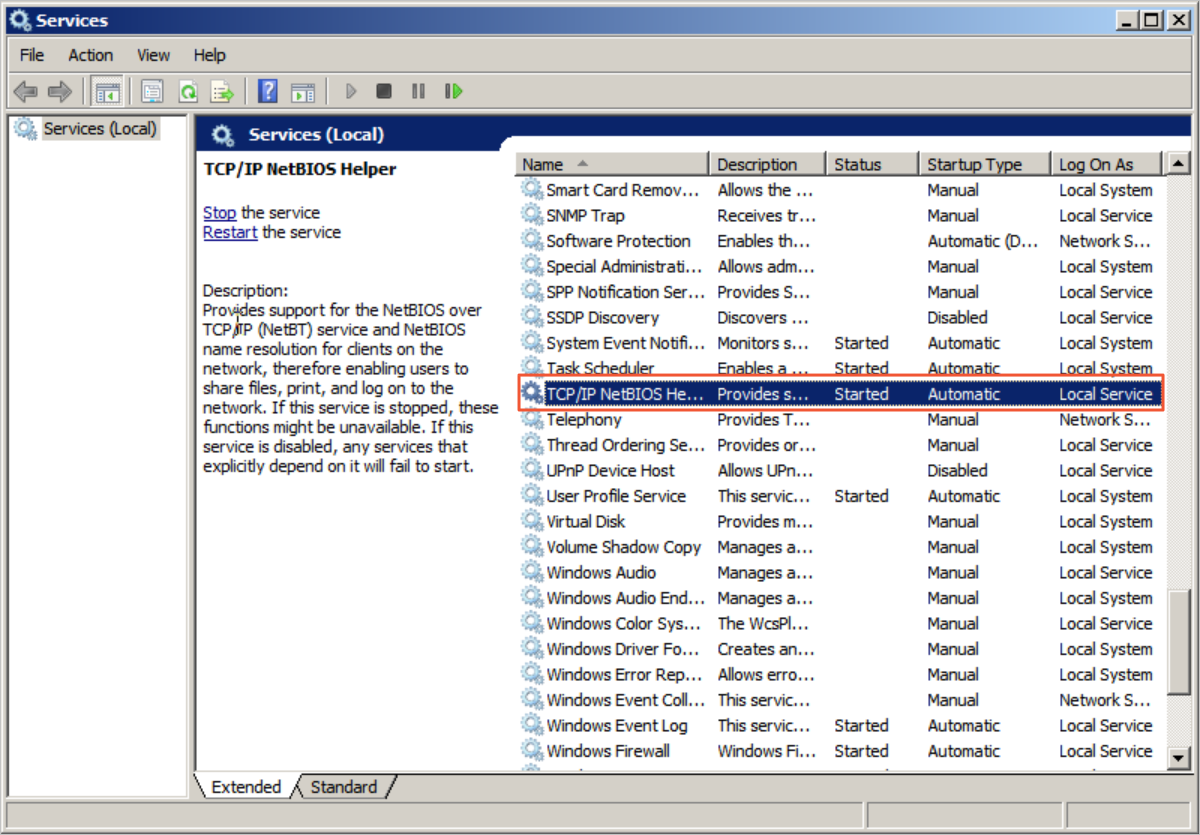Mount a NAS file system that uses the Server Message Block (SMB) protocol on a Windows server to share files. This topic describes how to mount an SMB file system on an Alibaba Cloud Elastic Compute Service (ECS) instance that runs Windows.
Prerequisites
You have created an ECS instance that runs Windows. For more information, see Create an ECS instance.
You have created an SMB file system on NAS and obtained its mount target address. The file system and the ECS instance must be in the same region and Virtual Private Cloud (VPC). For more information, see Create a General-purpose NAS file system in the console.
Network connectivity is established.
If you are mounting over a classic network, the ECS instance and the NAS file system must belong to the same Alibaba Cloud account.
The file system's permission group must grant access to the Windows ECS instance.
TCP port 445 must be open, as it is required for SMB communication.
If port 445 is not open, add a rule to the security group of the target ECS instance to allow traffic on this port. For more information, see Add a security group rule.
Step 1: Prepare the environment
Perform these steps once on each Windows server before you mount a file system for the first time.
Windows supports mounting only General-purpose NAS file systems.
If you want to mount a NAS file system from a non-Alibaba Cloud node, such as an on-premises server or a personal computer, see Access a file system from a data center.
If you are unsure which operating system to choose, see Recommended kernel images for Server Message Block (SMB) clients.
On the following Windows versions, you need to allow insecure guest logons.
For Windows Server 2016 and later, run the following command.
REG ADD HKEY_LOCAL_MACHINE\SYSTEM\CurrentControlSet\services\LanmanWorkstation\Parameters /f /v AllowInsecureGuestAuth /t REG_DWORD /d 1For Windows Server 2025, you also need to disable SMB signing. Use one of the following methods:
Method 1: Use Group Policy (GUI)
Press Win+R and enter
gpedit.mscto open the Local Group Policy Editor.Navigate to . Double-click Microsoft network client: Digitally sign communications (always), select Disabled, and then click OK.

Method 2: Use the registry
If you cannot use Group Policy, disable SMB signing by using the registry. Choose one of the following methods:
Registry Editor
Press Win+R and enter
regeditto open the Registry Editor.Navigate to the following key:
HKEY_LOCAL_MACHINE\SYSTEM\CurrentControlSet\Services\LanmanWorkstation\Parameters.Find the
RequireSecuritySignatureentry and set its value to 0.Restart the computer for the change to take effect.
Command line
Open Command Prompt as an administrator and run the following command:
reg add "HKLM\SYSTEM\CurrentControlSet\Services\LanmanWorkstation\Parameters" /v RequireSecuritySignature /t REG_DWORD /d 0 /fRestart the computer for the change to take effect.
Enable the Workstation service.
Navigate to , or press Win+R and enter
services.mscto open the Services console.In the list of services, find Workstation. Verify that its status is Started and its startup type is Automatic.
By default, the Workstation service is running.

Enable the TCP/IP NetBIOS Helper service.
Open the Network and Sharing Center and click the active network connection.
Click Properties, double-click Internet Protocol Version 4 (TCP/IPv4), and then click Advanced.
In the Advanced TCP/IP Settings dialog box, click the tab and select Enable NetBIOS over TCP/IP.

Navigate to , or press Win+R and enter
services.mscto open the Services console.In the list of services, find TCP/IP NetBIOS Helper. Verify that its status is Started and its startup type is Automatic.
By default, the TCP/IP NetBIOS Helper service is running.

Step 2: Mount the SMB file system
Mount an SMB file system manually for temporary access or configure an automatic mount that persists after server restarts. We recommend configuring an automatic mount after a successful manual mount.
Manually mount the file system
Mount the NAS SMB file system on your Windows ECS instance by using its mount target address.
Open a Command Prompt window and run the following command to mount the SMB file system.
net use Z: \\file-system-id.region.nas.aliyuncs.com\myshareParameter
Description
Z
The drive letter for the mapped file system. Choose an unused letter, especially if you plan to mount multiple file systems.
file-system-id.region.nas.aliyuncs.com
The mount target address that was generated when you created the SMB file system. Replace this placeholder with your actual address.
In the NAS console, click the file system ID, go to the Mount Targets tab, and then hover over the
 icon in the Mount Target column to find the address.
icon in the Mount Target column to find the address.myshare
The name of the SMB share. Do not change this value.
For Windows Server 2019 and later, use the
New-SmbGlobalMappingPowerShell cmdlet to ensure that the mount point is accessible to all users. The commands are as follows:If you are prompted for credentials, enter any valid credentials for the workgroup. For example, use workgroup\administrator and the password for the ECS administrator account.
Mount command
New-SmbGlobalMapping -LocalPath z: -RemotePath \\file-system-id.region.nas.aliyuncs.com\myshare -Persistent $trueUnmount command
Remove-SmbGlobalMapping -LocalPath z:Verify mount command
Get-SmbGlobalMapping
Verify that the SMB file system is mounted successfully.
Run the following command:
net useExample output
A similar output confirms a successful mount. You can now read from and write to the NAS file system on your ECS instance.

If the mount fails, use a script to automatically diagnose the issue or refer to common error codes for solutions. For more information, see Run the auto-check script to troubleshoot the failure of mounting an SMB file system on Windows and FAQ about mounting.
Optional: Automatically mount the file system
To automatically mount the SMB file system when the ECS instance restarts, create a startup script in the following location:
c:\ProgramData\Microsoft\Windows\Start Menu\Programs\StartUp\auto_mount.batOpen a Command Prompt window and run the following command to create the auto_mount.bat script.
echo %HOMEPATH%\mount.bat > auto_mount.batRun the following three commands to move the script to the startup folder, grant read and execute permissions to all users, and register the script to run at startup.
MOVE auto_mount.bat "c:\ProgramData\Microsoft\Windows\Start Menu\Programs\StartUp"icacls "c:\ProgramData\Microsoft\Windows\Start Menu\Programs\StartUp\auto_mount.bat" /grant everyone:rxREG ADD HKEY_LOCAL_MACHINE\Software\Microsoft\Windows\CurrentVersion\Run /f /v MyMount /t REG_SZ /d "c:\ProgramData\Microsoft\Windows\Start Menu\Programs\StartUp\auto_mount.bat"Run the following command to create the mount.bat script.
Mount without authentication
For scenarios that do not require authentication, use the following command:
echo net use z: \\file-system-id.region.nas.aliyuncs.com\myshare > "%HOMEPATH%\mount.bat"Mount with authentication
If your SMB file system uses Active Directory (AD) or ACLs and you need to mount it with domain credentials different from the current user, run the following command to configure the script.
echo net use z: \\file-system-id.region.nas.aliyuncs.com\myshare /user:user@domain password > "%HOMEPATH%\mount.bat"Replace the drive letter
z, mount target addressfile-system-id.region.nas.aliyuncs.com, domain usernameuser@domain, and domain user passwordpasswordwith your actual values.Restart the ECS instance.
After the instance restarts and you log back in, run the
net usecommand to verify the mount.ImportantRestarting the ECS instance interrupts your services. Perform this operation during off-peak hours.
References
To configure a permission group for your NAS file system, see Manage permission groups.
To learn about NAS performance, see NAS performance overview.
To learn how to mount from Linux, containers, or other clients, see Usage notes.
To set up Access Control Lists (ACLs) for different users with specific permissions, such as read-only or read-write, see Build an AD domain on a Windows instance, Join the mount target of an SMB file system to an AD domain, and Mount and use an SMB file system on a Windows client as an AD domain user.
To learn how to build Windows applications on NAS, see Windows applications.
To use NAS for content management systems and web service applications, see Web service and content management.
For more best practices for NAS, see Best practices.